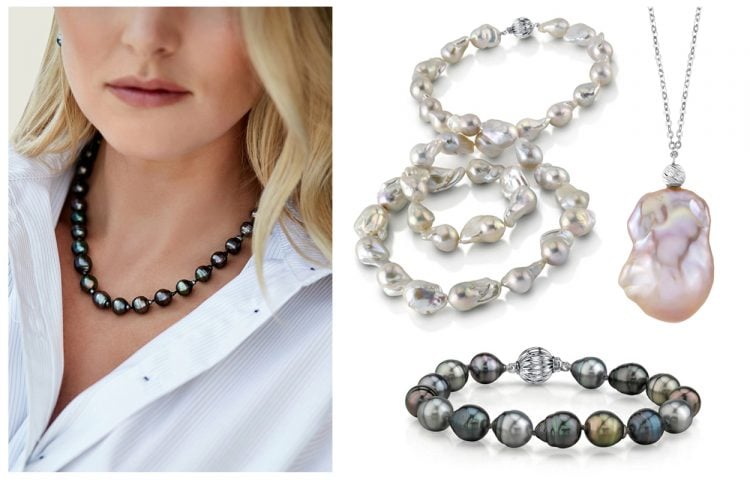They’re usually known for their flawless round shapes, immaculate surface and irresistible luster – but in fact, the gems of the seas come in many different shapes. Off-round pearls, teardrop pearls, long and elongated pearls, asymmetric gems and many more – all one-of-a-kind and perfectly imperfect. Meet Baroque Pearls, aka the gems of the seas that aren’t perfectly round, come in irregular shapes, have uneven surfaces, yet they are just as mesmerizing as their symmetrical counterparts.
What types of baroque pearls are there? How valuable are they? What should you be looking for when shopping for these pearls? And how are these gems actually made? We’re answering all these questions and more below, in our comprehensive Baroque Pearls Guide.
Frequently Asked Questions
Baroque pearls are real pearls, which means that they are valuable. However, not all baroque pearls are the same. In general, baroque pearls are less expensive than round pearls, but their value depends significantly on their type. Freshwater baroque pearls (which are abundant) are much more affordable than Tahitian black gems or South Sea baroque pearls. Off-round pearls are about 25-35% the cost of round pearls when compared with gems of similar type and size.
You can find both real and fake baroque pearls on the market. The easiest way to find out whether your pearl is real is by gently rubbing it along the surface of your tooth. A real baroque pearl will have a grittiness to it, while a fake one (both glass and plastic) will be perfectly smooth. Moreover, pearl jewelry pieces where you notice that all baroque pearls seem to have the same shape or to present intentional ridges instead of organic shapes are most likely fake.
There are many factors that contribute to the value of a baroque pearl: luster, size, pearl type and color. Luster refers to the pearl’s ability to reflect light. In terms of color, darker shades are more valuable than lighter ones because they are more rare. Larger pearls in desirable shapes (such as teardrop or shapes that present a certain symmetry) are more valuable than small and significantly misshapen pearls.

JEWELRY SPOTLIGHT:
Discover the mesmerizing beauty of Baroque Pearls in our stunning collections, featuring top quality Freshwater, Tahitian and South Sea Pearls. Choose a chic boho style pearl necklace, a versatile pearl bracelet, baroque Tahitian pearl necklaces or a dangling pair of pearl earrings and upgrade your jewelry collection with one-of-a-kind gems of the seas.
Baroque Pearls: Name Etymology and Popularity

The term ‘baroque’ finds its origins in the Portuguese word for ‘imperfect’ – ‘barocco’ in Portuguese. The term was first used in relation to a pearl in a French dictionary from the end of the 17th century, describing a gem that is imperfect in shape (off-round).
Baroque pearls gained a lot of popularity during the Renaissance years, when jewelers valued the gems for their unique and organic beauty. Their main use: in the creation of small figures, where the pearls were used as actual body parts. The finest example is a piece from the 16th century called ‘The Canning Jewel’, where a large baroque gem is used as a merman’s torso (see here).
The famous painting ‘Girl with the Pearl Earring’ by Johannes Vermeer depicts a young girl wearing a very large baroque pearl earring. The art piece, which gained its nickname as ‘Mona Lisa of the North’ was painted in the 17th century, during the Dutch Golden Age.
The most famous baroque pearl in the world is no other than ‘La Peregrina’. The gem has a long and rich history since being discovered in Panama in the 16th century. It as once owned by Napoleon, as well as by British royals, it was lost many times and later found, only to end up in the possession of Hollywood royalty.
Origins and Formation Process
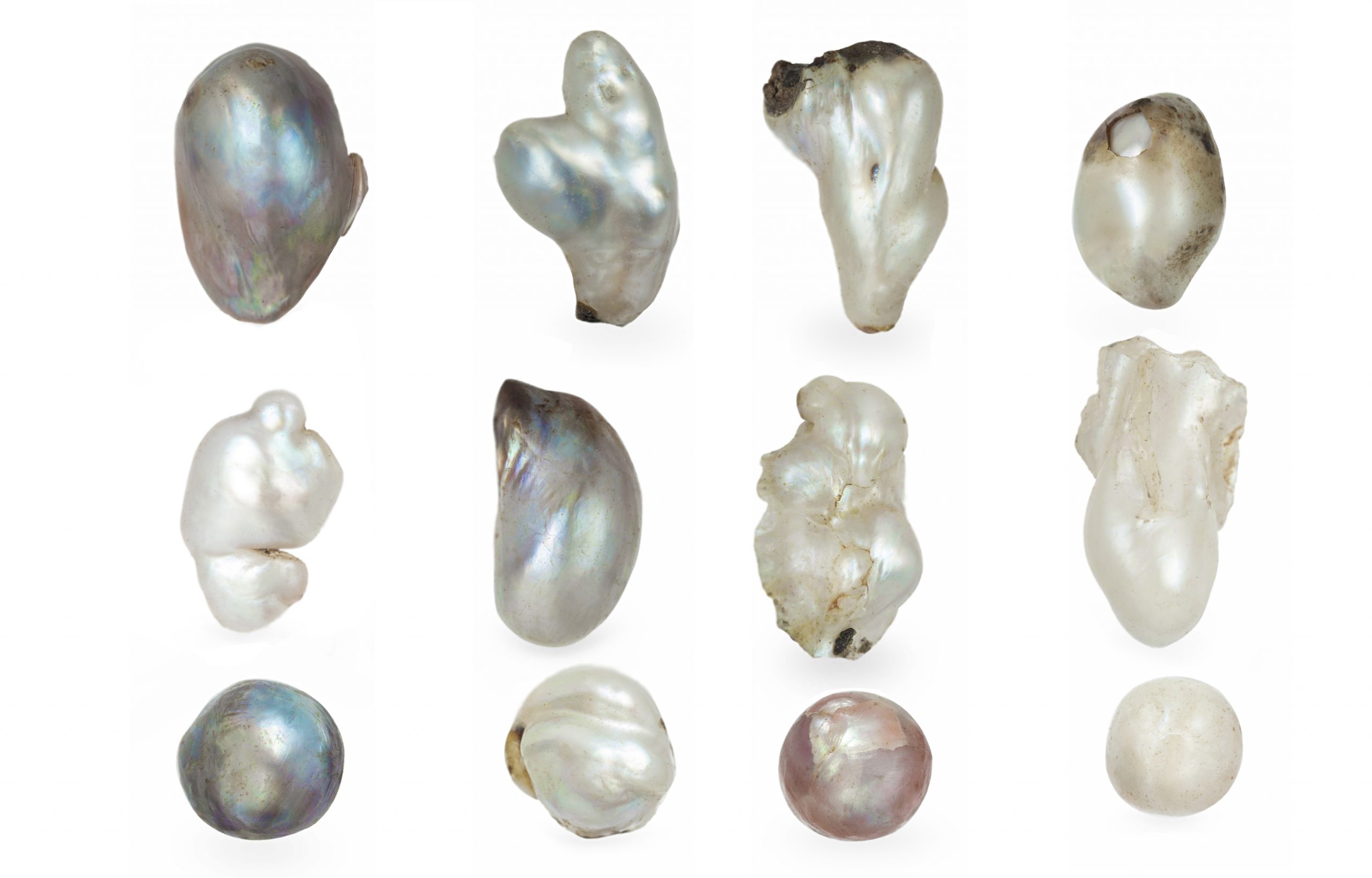
The vast majority of freshwater pearls are actually baroque pearls. In fact, over 90% of them. This means that the typical shape of a pearl is in fact, the misshapen or imperfect type – aka baroque. This is why round pearls are more valuable – they are simply more rare.
The pearl formation process does not always occur in the soft tissue. Some pearl cysts are stuck in muscular tissue, where they encounter resistance from the surrounding muscles. This ultimately leads to the formation of irregular, imperfect pearl shapes.
The vast majority of freshwater pearls are baroque because these gems are mantle tissue nucleated and not bead nucleated. As for saltwater off-round pearls, Akoya pearls are rare, and both South Sea and Tahitian baroque gems are available (although often teardrop shaped) and valuable. The latter two are produced by Pinctada Maxima (gold and white lipped oysters) and Pinctada Margaritifera (black lipped oysters). Almost half of the cultured Tahitian pearls are of the baroque and semi baroque pearls kind (slightly irregular in shape). While baroque pearls present irregularities all over, semi-baroque are usually of a more symmetrical shape (such as an oval or round), with irregularities usually found on one end.
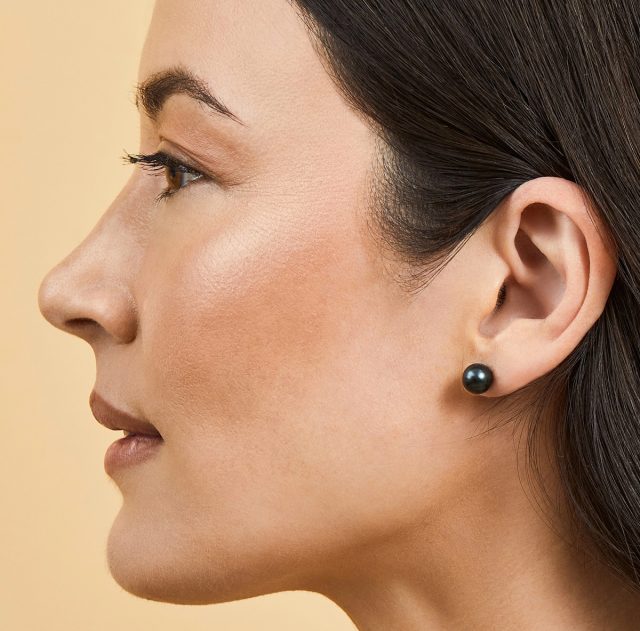
JEWELRY SPOTLIGHT:
Opt for chicness from every angle with our radiant Pearl Earrings. Browse our collection of studs and drop earrings including baroque pearl earrings and featuring stunning pearls in shades like pink, peach, white, golden and black. Choose baroque pearls, classic pearls, Akoya pearls, dainty Freshwater pearls, Tahitian or stunning South Sea gems. Shop your dream pearls at the best prices online!
The 12 Types of Baroque Pearls

Pearl shapes fall under 4 general categories: round, drop, baroque and circle baroque pearls (a subtype). Moreover, there’s a lot of variety in terms of shapes when talking about these pearls. Due to their wide range, each subtype is favored in the creation of specific jewelry pieces, from romantic to religious jewelry. Used as charms in designs featuring multiple gems or as statement gems in their own right, baroque pearls are highly versatile. Below, the many shapes of baroque pearls, which can be broken down into 12 different categories.
Coin Pearls
Coin pearls are round and flat, similar to a coin. Because of their large flat surface area, coin pearls have an amazing luster and are commonly used in jewelry.
Baroque Pearls
This is both the general name for non-round pearls and also a subtype. Elongated spherical pearls are known as baroque, and they usually have a dented and uneven surface.
Twin Pearls
When two pearls fuse together, they are known as twin pearls.
Potato Pearls
Potato pearls are small and lumpy, and, like the name suggests, similar to a tiny potato.
Cross Pearls
Cross pearls are rare, but they are highly sought after for religious jewelry. As the name suggests, cross pearls naturally form in the shape of a cross.
Stick Pearls
Stick pearls are also known as BIWA pearls. The main characteristics of stick pearls is that they are long, flat and narrow, like a stick.
Rice Pearls
Rice pearls are particularly small pearls that resemble grains of rice. They are rounded, but not perfectly round.
Egg Pearls
With wide bottoms and narrow tops, egg pearls resemble small eggs, as the name suggests.
Heart Pearls
Heart pearls are similar to coin pearls, but under the shape of a heart, making them great picks for romantic jewelry.
Teardrop Pearls
Teardrop pearls have a pear-shaped silhouette, they resemble teardrops and are often used in earrings. They are at high demand and often more valuable than other types of baroque pearl shapes.
Leaf Pearls
Leaf pearls are paper thin with an uneven surface. They are the most delicate and the thinnest baroque shaped pearls.
Keshi Pearls
Keshi pearls are the rarest type of baroque pearls. They are created when the mollusk rejects the seed but continues to develop the pearl, so keshi pearls do not have a center particle. They are elongated and extraordinarily lustrous and few know that keshi pearls are, in fact, composed only of nacre.
Baroque Pearl Jewelry Types
Baroque pearl jewelry comes in many styles and designs, ranging from classic and elegant to modern and bohemian. Due to the off-round shape of these pearls, baroque pearl jewelry is slightly less formal than traditional pearl jewelry. A wide variety of designs include single pearls on more casual settings, from silver to rubber and leather. Next, we’re taking a look at some of the most popular baroque pearl jewelry types.
Dangle Baroque Pearl Earrings
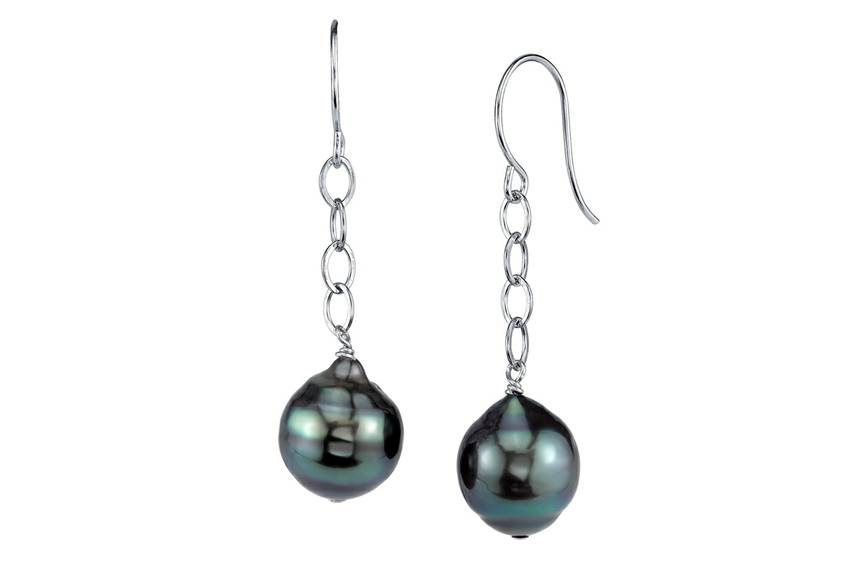
Stud earrings and baroque pearls are rarely a successful combination. On the other hand, the market features an impressive variety of dangle earrings featuring off-round pearls, including drop styles, hoop earrings, threaders, chandelier earrings and many more types of earrings. Opt for baroque pearl earrings for a day-to-night look that feels and looks effortless without compromising on chicness.
Shop the Tahitian South Sea Baroque Pearl Dangling Tincup Earrings
Classic Strand Necklaces

Classic strand necklaces featuring baroque gems are a great alternative to the slightly more traditional strands featuring round pearls. Opt for a baroque pearl necklace adorned with Freshwater pearls, Tahitian Pearls or South Sea gems if you are looking to boost the uniqueness factor or add visual interest to a more formal ensemble.
Shop the 14-15mm White South Sea Baroque Pearl Necklace
Bohemian and Surfer Style Necklaces

For a more casual look, go for bohemian baroque pearl necklaces. Including pearls set on leather or rubber, surfer-style neckpieces are a beach staple. They are suitable for both men and women and have an effortless, unisex appeal that adds weekend / vacation vibes to any casual look.
Shop the Golden Baroque Pearl Leather Necklace
Baroque Pearl Pendants
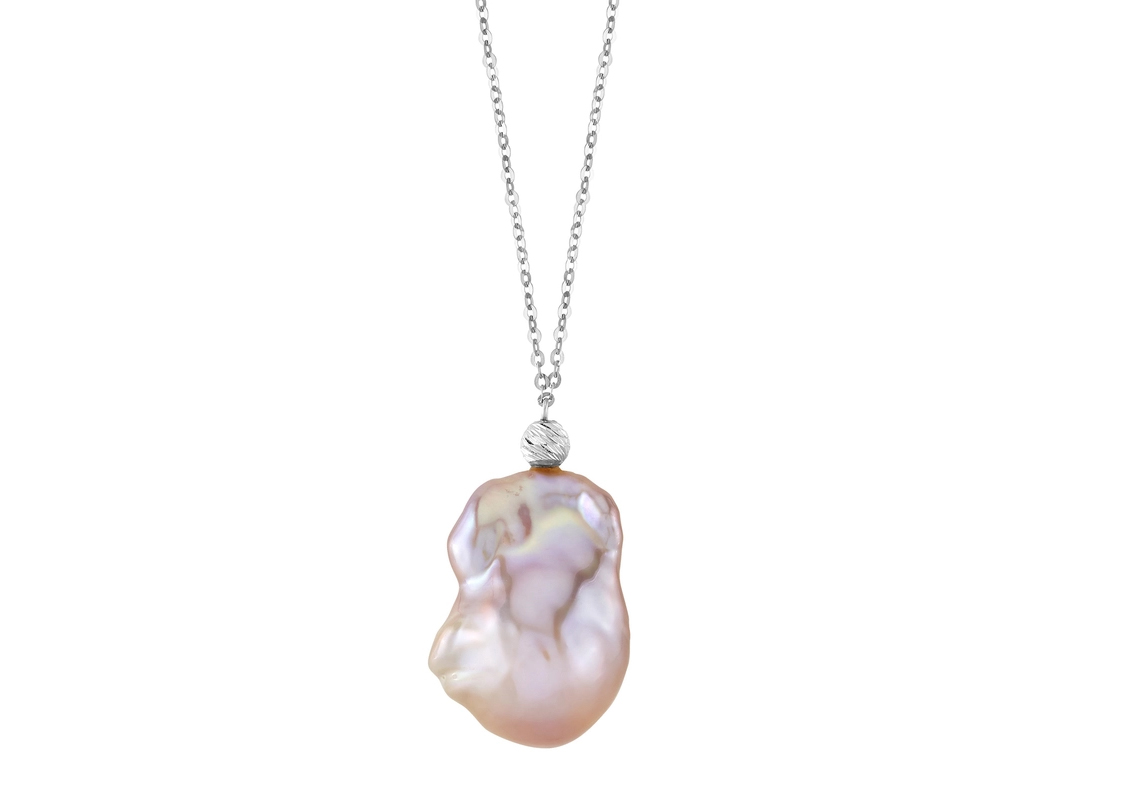
Round pearl pendants are a classic choice, but if you are all for unique gemstones, opt for a baroque pearl necklace featuring a statement irregular pearl. You can choose a gem with subtle irregularities (like a pear-shaped, oval or teardrop gem) or you can go for a highly irregular pearl and treasure it for its uniqueness.
Shop the 15mm Pink Freshwater Baroque Pearl Solitaire Designer Pendant
Classic Bracelets

Black, white, golden or pink, baroque pearl bracelets are true statement pieces that pair well with both business wear and cocktail-ready attire. Choose a piece that speaks to you, whether it’s one featuring more uniform gems or highly irregular ones that belong to a cohesive color palette.
Shop the Tahitian South Sea Multicolor Baroque Pearl Bracelet – AAA Quality
Bohemian Bracelets

Similar to baroque pearl necklaces, bracelets featuring off-round gems of the sea denote beachy appeal and pair well with boho ensembles, from weekend attire to resort wear and downtime style. Choose a boho style pearl bracelet on leather – and wear it on its own or stack it up with other favorites.
Shop the Tahitian South Sea Baroque Pearl Leather Bracelet
Top Reasons Why You Should Choose Baroque Pearls
There are many benefits to choosing baroque pearls – keep on reading as we touch on the main points.
Unique Appeal – Baroque pearls come in distinctive, unique shapes that all offer visual interest and appeal. These days, the imperfections of these pearls are no longer seen as such. Instead, designers and buyers alike celebrate the organic and highly personal look of off-round pearls.
Self-Expression – Due to their uniqueness, baroque pearls allow the wearer to express their style in a non-conventional way. While they are still precious gems, their different shapes and appeal make wearing these gems a highly personal experience.
Affordability – One of the more practical advantages of opting for baroque and semi baroque pearls is that they come at lower prices. Round pearls come with double or triple price tags, but baroque gems offer pearl lovers the possibility of owning real gems at a fraction of the price.
Gorgeous Colors and Luster – Little known fact: often times, the irregular shapes of a baroque pearl actually accentuate both the luster and the iridescence of the gem – and the same goes for its color. Tahitian pearls in particular display an array of colors in a single gem, providing endless iridescence and different overtones from different angles. As for luster, the ridges and denivelations often improve luster due to the fact that the light bounces back, allowing refracting light from every angle.
Final Thoughts:
And there you have it: your ultimate guide on one of nature’s most beautiful gems, aka Baroque Pearls – plus a few pieces ready to upgrade your jewelry box. From the gorgeous teardrops to the coin-like gems and from the dainty freshwater gems to the utterly lustrous, these pearls come in the widest range of styles, perfect for any occasion and outfit, from casual to office-ready and formal. Let us know in the comment section below: what types of pearls are your favorite? Classic rounds or uniquely shaped baroque pearls?

JEWELRY SPOTLIGHT:
The classic beauty of a pearl necklace is simply unmatched. Luster. Elegance. Glow. Real pearls have it all. Whether you’re looking for 30th anniversary gifts, unique types of earrings including baroque pearl earrings, or, why not, gifts for grandma or mom, browse our extensive collection of premium Pearl Necklaces, featuring both traditional pearls and baroque pearls. Discover the delicate charm of Freshwater Pearls, lustrous Akoya pearls, and elegant Tahitian and South Sea Pearls in a gorgeous assortment of shades.

